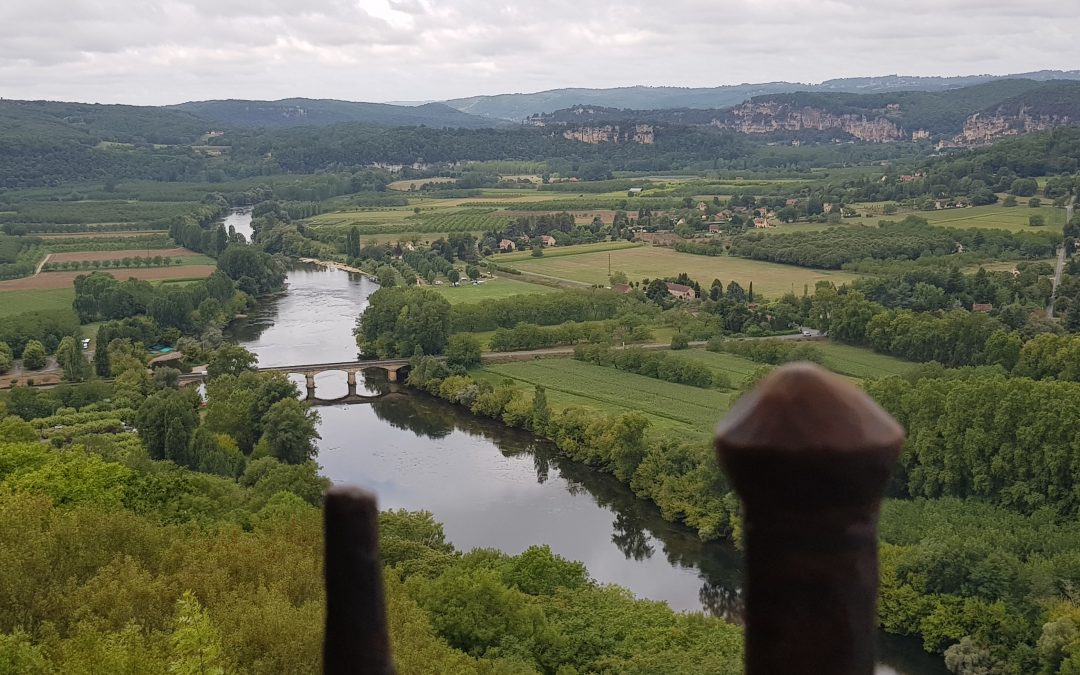
Dordogne Valley, France
Round the Corner World
Devon- UK, Europe, US, and beyond –

Dordogne River from Village of Domme, France
This was the view Henry Miller wrote about, when he said “Just to glimpse the black, mysterious river at Domme from the beautiful bluff … is something to be grateful for all one’s life”.
Domme is a small village on top of a rocky hill overlooking the valley, a medieval stronghold with outer walls and gates still standing.
It was a beautiful drive up the hill to the Domme village, and stunning views all around, especially overlooking the Dordogne river valley with patches of fertile growing fields of walnuts which is a speciality of the area. Another speciality are the truffles.



The Templar Knights were imprisoned here between 1307- 1318 evident from the Templar crosses carved into the wall in their tower cell dating back to that period.
We arrived in the village on a slightly overcast Sunday morning, clear enough to enjoy the views, though not the best day for taking pictures, but the dramatic character of the landscape speaks for itself . We explored this little bustling town, and found a very interesting tiny library in the middle of the town, with lots of English books to dive into. Didn’t get to see the caves which were accessed from the middle of the town, well not this time, that is something for next time.




In the library there, I found a gem of a book called “24/7 French Lessons” by Karen Eberwein from California. It describes her year in a nearby village in the Dordogne Valley where she sets out on her quest to learn French during that year, by completely immerging herself in village life and the social activities of the area.
Leaving California to persue her dream, she rents a cold cottage in Cenac et St. Julien and begins to set out some strategies for how to connect up to the community around her. It is not an easy task, and it is fun to read about.


Apart from the author’s various successful and not so successful attempts to making friends with the French in her village and the different ups and downs she has with that, I was impressed by how she dealt with the challenges of every day, living in a cold cottage, heated by a woodburner and oil system during the winter months, using mainly the woodburner, as she was trying to save on the cost of oil.
Here is an extract from her book describing her way of coping with the cold:
“Many mornings I checked the temperature to find a negative number. I felt quite proud of myself living in below zero conditions; although I must admit, I wore four layers of wool clothes, gloves, scarf, hat and fuzzy Uggs most of the time, and that was inside the house. [ ] A daily morning and evening routine needed to be done in order to survive the cold. It made me feel a kinship to pioneer women. First, I would carry firewood from below the house, up the step, cement walkway to the front door, and make a leaning, poorly-stacked pile of the day’s firewood under the eaves. [ ]
The next step was removing the ash from the little, black potbelly stove. The house was heated by the wood-burning stove in the sitting room and by an oil burning heating system throughout the two-story house. Of course the oil system was very expensive, so I tried not to use it and used the stove as often as I could. Once the chamber in the stove was clean, I disposed of the ash-filled plastic bags in the trashcans under the house. Then was the moment for the magic of building the perfect fire form. I experimented with different structures, but I found the best shape was the tepee made of sticks and small pieces of wood on a bed of crumbled newspaper. Any burnable trash like egg cartons was useful too. This source of welcome warmth waited for me until my classes or errands were finished for the day. On a typical winter day, I had a fire going from 4:00 p.m. until 10 p.m. I never lit a fire during a tyical morning because I often left the house”.
(pp 12-13)


Later in the day the sun came out and we were able to find a nice place to have a swim in the river further down the valley 🙂


Recent Comments